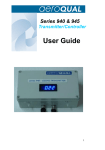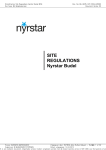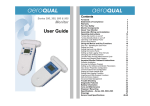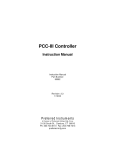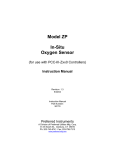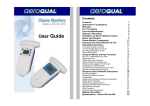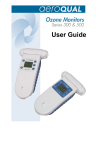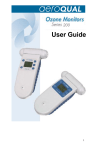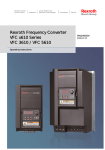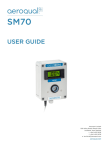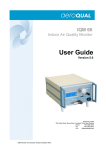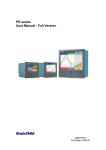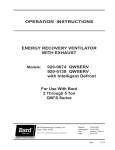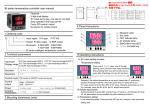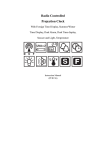Download S-960 User Manual
Transcript
Series S960s UV Ozone Photometer User Guide Quick Start Guide 1. 2. 3. Unpack monitor and check supplied components are correct Connect 24 VDC power supply via the cable gland to the screw connectors on the PCB. Configure monitor Using computer: · Attach twisted pair cable to RS485 pins on screw connector · Connect twisted pair to RS485 converter connected to computer · Load and run Configuration software · Turn on monitor · Configure monitor setpoints, ID etc. 4. Connect Outputs (A) If RS485 see “Operation as RS485 Transmitter” (B) If 4-20 mA see “Operation as 4-20mA Controller” (C) If Relay controller see “Operation as Relay Controller” (D) If the Display is fitted and the 4-20 mA loop is not being used see “Operating the LED Display if 4-20 mA loop is not being used” 5. Connect the inlet filter and sample tubing if required 6. Power on and allow monitor to warm up for 30 to 60 minutes to reach optimum operation. 1 Table of Contents Quick Start Guide 1. Description 1.1 Components supplied 1.2 Components not supplied but required 2.Operation 2.1 Description of outputs 2.2 Operation as a Relay Controller 2.3 Operation as a 4-20 mA Transmitter 2.4 Operation as a RS485 Transmitter 3. Configuring the Series 960s 3.1 Connecting the R51: RS-485 to RS-232 Converter 3.2 Using a USB to RS485 converter 3.2.1 Installation of Moxa UPort1150 3.3 Procedure for configuration of S960s/965s 4. S960s/965s Specification and Photographs 5. Technical Support 6. Troubleshooting 7. Diagnostics 8. Appendix 8.1 Copyright 8.2 Warranty 8.3 Series 960s/965s RS485 Communication Protocol Version 1.1 1 3 3 3 4 4 5 5 10 11 11 12 12 12 15 16 17 20 21 21 22 24 20.04.11 Aeroqual Limited 109 Valley Road, Mount Eden, Auckland, New Zealand phone +64 9 623 3013 fax +64 9 623 3012 email [email protected] web www.aeroqual.com 1. Description The Aeroqual Series 960s UV Ozone Photometer is designed to measure and control ozone concentrations, and to communicate to a variety of hardware systems. The Series 965s also measures Temperature and Relative Humidity and transmits this on the RS485 output. The monitor contains a pump to provide sample flow. Sample tubing (6.25mm OD) is attached via the inlet compression fitting. An ozone scrubber is fitted to the exhaust line inside the unit . The Series 960s/965s UV Ozone Photometer can operate as: a) a relay controller with user controlled setpoints, b) a 4-20 mA gas transmitter and c) as a RS485 gas transmitter for single and network use. PC Networking & Data logging Software for connecting the RS485 network of S960s/S965s monitors to a computer is available as an option. Please contact your distributor if you require this. Available options · 4.5 digit LED display. · Relay output board 1.1 Components Supplied Series 960s or 965s base unit (transmitter / controller) UV Ozone Sensor (installed) Temperature and Relative Humidity Sensor (S965s only) User guide & Configuration Software CD 1 x external filter with fittings Please check that all these components have been supplied and contact your dealer or Aeroqual on email at: [email protected] if any of the components are missing. 1.2 Components not supplied but required 24VDC 2A power supply RS485/RS232 converter or RS485/USB converter PC for configuring the monitor. Multi-strand twisted pair cables for connections 3 2. Operation 2.1 Description of Outputs DIAG This output is designed to enable detection of sensor faults. This is normally floating but is set to GND when the sensor fails. Thus it can be considered a "switch" which is closed when the sensor fails. This can be used to activate an alarm or relay and can also be monitored with a PLC. The output is an open collector current sink. The maximum rating of the transistor output is 24VDC at 150mA. LoALM This is set to GND when low alarm is activated. It is floating at other times. Use the Configuration Program to set the Lo alarm set point. The output can be used to drive an alarm relay or similar. The alarm can be set to trigger above or below the set point using the configuration software. The output is an open collector current sink. The maximum rating of the transistor output is 24VDC at 150mA. Should you connect a relay coil or any other inductive load to the transistor outputs, a back EMF suppression diode must be fitted across the load. HiALM This is set to GND when high alarm is activated. It is floating at other times. Use the Configuration Program to set the Hi alarm set point. The output can be used to drive an alarm relay or similar. The output is an open collector current sink. The maximum rating of the transistor output is 24VDC at 150mA. Should you connect a relay coil or any other inductive load to the transistor outputs, a back EMF suppression diode must be fitted across the load. CNTRL This is set to GND when the gas concentration is rising in the range from below Control low set point to the Control high set point at which stage, it is set to floating. It remains floating until the concentration falls below the Control low set point at which point, it is reset to ground. Use the Configuration Program to set the Control set points. This output can be used to control, for example, a gas generator or vent in a process operation. The output is an open collector current sink. The maximum rating of the transistor output is 24VDC at 150mA. Should you connect a relay coil or any other inductive load to the transistor outputs, a back EMF suppression diode must be fitted across the load. STBY STBY is a hardware toggle switch. If it is briefly pulsed (about 50ms) to GND it puts the S960s into Standby mode and turns the pump off. If pulsed again to GND it will return to normal operation. This can be used to protect the sensor during process room cleaning and/or to reduce power and extend sensor life when the sensor is not needed. 2.2 Operation as a relay controller The S960s/S965s can be used as a simple relay controller using the alarm or control outputs which are open collector current sinks. They are set to ground when activated according to their setpoints. The setpoints can be configured by computer using the supplied Configuration program or using a R950 programmer (see Aeroqual for more information). It is recommended that the DIAG output is always used to alert a sensor fault condition. Procedure 1. Connect 24 V DC power supply 2. Connect alert relay/alarm to DIAG output screw connector if required 3. Connect relay ground toggle to STDBY pin on the screw connector if required. 4. Connect control relay to CNTL output on the screw connector if required. 5. Connect relays to LoALM and/or HiALM alarm outputs on the screw connector if required 6. Power on and test response. 2.3 Operation as a 4-20 mA transmitter The Series 960s/965s can be connected to a PLC or current sensing device via the 4-20 mA output to provide concentration information. The output is linearly proportional to concentration. The full scale (20 mA) value is factory set but can also be user configured with the Configuration software supplied. If the sensor fails the output will be 20 mA. It is also recommended that the DIAG (diagnostic) output be used to monitor for fault conditions. The 4-20 mA output loop is opto-isolated and it is recommended that it be powered by a separate power supply with a voltage in the range 12-24 V applied with the correct polarity as labelled (see diagram below). This will produce the most reliable connection method. If optoisolation is not important then the 4-20 mA loop may be powered by the same power supply as the unit. LED display models are designed to operate in conjunction with the 420mA circuit and the loop needs to be powered correctly for the display to function correctly. 5 Note: HiALM, LoALM and DIAG are also Transistor outputs. External Relay EXTERNAL DEVICE L N E 100-240VAC GND + POWER SUPPLY (24VDC) Procedure 1. Connect the 4-20 mA loop on the screw connector to the power supply and current measuring device (eg PLC) ensuring the polarity is correct. Please refer to the diagrams below. ***Caution: if the polarity is incorrect the 4-20 mA output may be permanently damaged *** 2. 3. Power on the S960s/965s and PLC Check the PLC or current sensing device to ensure data is present. 4-20 mA wiring diagram for Loop and Display (with optoisolation) 4-20mA + - GND + POWER SUPPLY (24VDC) 7 + PLC or current meter (remote display) - GND + POWER SUPPLY 4-20 mA wiring diagram for Loop and Display (without opto-isolation) 4-20mA + - GND + POWER SUPPLY (24VDC) PLC or current meter (remote display) + Operating the LED Display if 4-20 mA loop is not being used LED display models are designed to operate in conjunction with the 420mA circuit. If the 4-20mA output is not being used the display can still be enabled by connecting two wire loops (see diagram below) on the screw terminal between: a) the positive 4-20mA pin to the +12v output pin and b) the negative 4-20mA pin to GND (ground). 4-20mA + - GND + + POWER SUPPLY (24VDC) DISPLAY *Please note, models purchased with display will have the LED display pre-wired 9 2.4 Operation as a RS485 Transmitter The Series 960s/965s unit can communicate over a RS485 bus. Each monitor has an ID which can be user set via the Configuration software and up to 255 units networked together. Aeroqual supplies a Configuration program to configure the S960s/S965s over the RS485. Aeroqual can also supply Networking software to set up a RS485 network of S960s/S965s units linked to a computer. Connecting via RS485 1. 2. 3. Connect a 24 vDC power supply to the power input on the PCB screw connector. Use twisted pair cable to connect the RS485 lines on the screw connector to the RS485 hub, bus or converter . Power up the monitor and run the communication software on your computer or PLC Network Settings If the S960s/S965s is to be used as part of a “daisy chained” RS485 network a number of settings need to be adjusted. Jumpers 1. Jumper settings The termination resistors need to be set correctly to ensure the network communication is stable. The jumpers JP1, JP2, JP3 are to install termination resistors on the RS485 communication lines. Remove the jumpers J1, J2, J3 for all S960s/965s units in a chain except the last S960s/965s unit in the network chain. If there is only one unit then set the jumpers in place. 2. ID Settings Monitors on the network require unique IDs so they can be distinguished on the RS485 network. The ID of the unit is factory set as 1 and therefore it will need to be changed. Use the Configuration program to change the IDs (see the section on Configuring the monitor). 3. Configuring the S960s/S965s The Series 960s/965s alarm and 4-20 mA output scale settings can be modified using a computer and the supplied S900 Configuration Program or using a R950 purpose made hand held communica- tion tool. For further details on the R950 contact your supplier or Aeroqual Limited ([email protected]) To configure the S960s/S965s by computer you will need an RS232/ RS485 or USB/RS485 converter. There are many RS232/RS485 converters on the market. Only certain brands will function well with Aeroqual’s products. Aeroqual can supply a converter (R51) suitable for configuring a single monitor (it is not suitable for a S960s network). Converters which have been tested by Aeroqual can be purchased from Aeroqual or it’s distributors, or contact Aeroqual for recommended brands on [email protected]. Computer requirements CD-ROM Drive RS232 port Windows 95 or later. 45 MB spare hard drive space Additional components required: - 24V power supply - RS232/RS485 or USB/RS485 converter - RS485 wired S960s/S965s 3.1. Connecting the R51: RS-485 to RS-232 Converter Connect to PC serial COM port or USB via R52 TD(A) connect to RS485B TD(B) connect to RS485A RS-485 to RS-232 Converter to Series 960s/965s TD(A) connect to RS485B TD(B) connect to RS485A GND – not required GND – not required +12V – not required 11 3.2 Connecting an USB to RS485 converter Recommended supplier: Moxa, www.moxa.com Note: Aeroqual S900 series monitors communicate via 2 wire RS485 so the converter must be configured to RS485 2W using software supplied with the converter. Configure a Moxa UPort 1150 for RS485-2 wire mode as follows: 1. 2. 3. 4. 5. 6. 7. 8. 9. 10. Install software from the CD provided with Moxa UPort 1150 Attach Moxa UPort 1150 USB device to USB port Once the drivers have been installed for the device, open up the device manager (found under control panel/system/ device manager (Windows Vista), OR Control panel/system/ hardware/device manager (Windows XP) Right-click on the UPort 1150 item and select properties Expand the “Multi-port serial adapters” item Click on the "Ports Configuration" tab Select the appropriate COM port Click on the button labeled “Port Setting” Under heading “Interface”, select the “RS-485 2W” entry from the drop down list Click OK in this window and in the original window opened from the Device Manager in step 5 3.3 Procedure for S960s/S965s configuration: 1) Plug in and install the USB or RS232 to RS485 converter into your computer. 2) Connect the Series 960s/965s RS485 port leads to the converter 3) Install the Aeroqual Series 960s/965s Configuration Program on the computer if not already installed. 4) Power up the Series 960s/965s unit. 5) Run the Aeroqual Series 900 Configuration Program. 6) Select Unit by entering the ID of the S960s/965s you wish to modify (and click on "Download” to download the unit’s current values). 7) Modify settings 8) Click Upload to upload the settings to the S960s/965s 9) Click Exit 10) Power down the S960s/965s and install. Port ID Click on “Port” menu and select “Change port ID” to change ID to your requirement in the range 1 to 255. Caution: if you are setting up a network please ensure each unit has a unique ID otherwise there will be conflicts and data loss. Alarms High alarm and low alarm setpoints can be set by clicking on the appropriate window and entering the required activation setpoint. Please note: High alarm setpoint must be greater than low alarm setpoint. The low alarm trigger determines whether low alarm is activated by being above or below the setpoint. Click mouse on the button to select. The Alarms can be enabled or disabled by clicking on the button alongside Enable or Disable, respectively. Control The control output is triggered according to the band set by the Control high and Control low values. Control high must be greater than Control low. The action of this output is designed to enable control of an ozone generator. The Control output will be "on" when the concentration is rising in the range from below Control low until it hits Control high when it turns off. It remains off until the concentration falls below Control low. 13 4-20 mA output scale This sets the gas concentration scale that corresponds to 4 -20 mA. Each sensor head type has a default setting but the user can modify this by clicking the user define button and entering the required value that corresponds to 20 mA. (NOTE: The LED display is calibrated for the default settings only and will not operate correctly if the default range is altered – if you are in any way uncertain of this, please seek technical assistance from Aeroqual.) Upload Clicking this button uploads the settings to the S960s/965s. Download Clicking this button downloads the settings from the S960s or S965s. Use this function to check the settings are correct. 4. S960s/S965s Specification and Photographs Calibrated Range Precision 0-200ppm Ozone <±5% of reading below 0.2ppm <±0,01ppm below 0.2ppm 0.01ppm BLDC diaphragm pump <60s 0.4 ± 0.05 LPM Kynar, Teflon PFA, quartz, aluminium, viton 5µm pore size, 37mm PTFE filter Kynar ¼” compression fittings Resolution Sampling method T90 Sample flow rate Wetted materials Inlet filter Pneumatic connections Environmental operating conditions Temperature 0-40°C (32-104°F) RH 0-95% (non-condensing) Power Requirements 24VDC, 2A Display (optional) 4.5 digit LED (red) Connectors Screw Analogue outputs 4-20mA (opto-isolated) 12-24VDC (30VDC max), maximum loop resis tance 500Ω at 24V, 16 bit resolution Digital interface RS485 (2 wire). See § 8.5 for protocol Jumpers J1, J2, J3 termination resistors for RS485 network ID 1 (Default) User configurable from 1-255 Transistor outputs (optional) 4x open collector transistor outputs (Control, Diagnostics, High Alarm, Low Alarm) User configurable set points Low alarm, High alarm, Control Inputs Standby toggle (turns off pump) Enclosure ABS Plastic, IP65 (except inlet and exhaust) Enclosure size 340 W x 150 H x 100 D (mm) Mounting Screw fix 150 mm 340 mm 15 5.0 Technical Support: If you require technical support in the operation or maintenance of your Series 960s, please contact Aeroqual: Aeroqual Limited 109 Valley Road, Mt Eden, Auckland 1024, New Zealand Phone: +64 9 623 3013 Fax: +64 9 623 3012 Email: [email protected] 6. Troubleshooting Fault Description Possible cause Remedy No power Lead connection broken Reconnect power lead Power supply failure Replace supply S960s/965s damaged Replace unit RS485 communications unstable RS485/RS232 faulty 24V power adaptor Reconfigure/replace adaptor Connections broken Reconnect leads ID incorrect Check ID Noise on cable use shielded twisted pair cable 4-20 mA output failure 30V input exceeded Replace S960s/965s Network unstable ID conflict Modify IDs so that no S960s/965s units share the same ID Noise on leads use shielded twisted pair cable Jumpers set incorrectly Set jumpers correctly S960s/965s units too close together The leads between S960s/965s units should be a minimum of 30 cm in length. Display shows -1 over-range (>20 mA) reverse loop current Loop polarity is incorrect. Reverse this. Incorrect loop polarity can cause irreversible damage to the S960s/S965s. Reduce loop current. Display shows over-range loop current (>20 mA) Reduce loop current 4-20 mA Loop not powered Power loop. The display requires the loop to be powered to read correctly 1 Display shows -.125 17 Sensor showing high baseline reading under zero gas conditions Sensor showing higher than expected reading in the presence of sensor gas Background gas level Move sensor to clean air higher than normal and recheck baseline Interferent gas present Move sensor to clean air and recheck baseline Sensor damaged Replace sensor Flow incorrect Measure sample flow and compare with specification. If incorrect check for leaks and/or replace pump. Zero calibration incorrect Zero calibrate sensor Span calibration incor- Span calibrate sensor rect Sensor correct Check calibration of gas generator. Interferent gas present Move sensor to clean air and check reading upon exposure to known gas concentration Sensor calibration lost Replace /refurbish sensor Flow incorrect Measure sample flow and compare with specification. If incorrect check for leaks and/or replace pump. Sensor showing lower than expected reading in the presence of sensor gas Span calibration incor- Span calibrate sensor rect Sensor correct Sensor nated inlet Check calibration of gas generator. contami- Clean sensor inlet filter and mesh Interferent gas present Move sensor to clean air and check reading upon exposure to known gas concentration Gas reactive and de- Move the monitor closer composing before detec- to the source of the gas tion Sensor calibration lost Sensor output noisy S960s/965s power sup- Install regulated power ply unregulated supply Local air flow too high Environmental tions fluctuating Reduce air flow condi- Reduce fluctuations Pump not working correctly 19 Replace/refurbish sensor Replace pump. 7. Diagnostics The S960s/965s has inbuilt diagnostics to detect sensor faults. If the sensor fails it can be easily replaced by simply removing and installing a new one (see sensor manual for details). The failed sensor can be sent back to Aeroqual for refurbishment or disposal. Table of fault condition diagnostics Fault description No fault DIAG output 4-20 mA output RS485 output floating valid gas reading Status1 = 0x00 last valid gas reading Status1=0x01 last valid gas reading Status1=0x02 no reply Sensor fault failed GND valid gas reading 20 mA Sensor fault aging GND 20 mA Sensor not fitted correctly GND Oscillates between 4 and 20 mA 8. Appendix 8.1 Copyright Copyright Aeroqual Limited. All rights reserved. Reproduction, transfer, distribution or storage of part or all of the contents of this document in any form without the prior written permission of Aeroqual Limited is prohibited. “Aeroqual” and “Aeroqual Limited – Making the Invisible Visible” are registered trademarks of Aeroqual Limited. Other product and company names mentioned herein may also be trademarks or trade names. Aeroqual operates a policy of continuous development. Aeroqual reserves the right to make changes and improvements to any of the products described in this document without prior notice. Under no circumstances shall Aeroqual be responsible for any loss of data or income or any special, incidental, consequential or indirect damages howsoever caused. The contents of this document are provided "as is". Except as required by applicable law, no warranties of any kind, either express or implied, including, but not limited to, the implied warranties of merchantability and fitness for a particular purpose, are made in relation to the accuracy, reliability or contents of this document. Aeroqual reserves the right to revise this document or withdraw it at any time without prior notice. The availability of particular products may vary by region. Please check with the Aeroqual dealer nearest to you. © Aeroqual Limited 2011. All rights reserved. 21 8.2 Warranty Aeroqual warrants this product to be free from defects in material and workmanship at the time of its original purchase by a consumer, and for a subsequent period as stated in the following table: Products Warranty Period Series 960s/965s UV Ozone Photometer One year from the date of purchase UV Lamp Six months from the date of purchase Other Accessories One year from the date of purchase This warranty is expressly limited to the original owner who purchases the equipment directly from Aeroqual or from an authorized Aeroqual dealer. What we will do If, during the warranty period, this product fails to operate under normal use and service, due to improper materials or workmanship, Aeroqual subsidiaries, authorized distributors or authorized service partners will, at their option, either repair or replace the product in accordance with the terms and conditions stipulated herein. Conditions The warranty is valid only if the original receipt issued to the original purchaser by the dealer, specifying the date of purchase, is presented with the product to be repaired or replaced. Aeroqual reserves the right to refuse warranty service if this information has been removed or changed after the original purchase of the product from the dealer. If Aeroqual repairs or replaces the product, the repaired or replaced product shall be warranted for the remaining time of the original warranty period or for ninety (90) days from the date of repair, whichever is longer. Repair or replacement may be via functionally equivalent reconditioned units. Replaced faulty parts or components will become the property of Aeroqual. This warranty does not cover any failure of the product due to normal wear and tear, damage, misuse, including but not limited to use in any other than the normal and customary manner, in accordance with Aeroqual’s user guide for use, faulty installation, calibration and maintenance of the product, accident, modification or adjustment, events beyond human control, improper ventilation and damage resulting from liquid or corrosion. This warranty does not cover product failures due to repairs, modifications or improper service performed by a non-Aeroqual authorized service workshop or opening of the product by non-Aeroqual authorized persons. The warranty does not cover product failures which have been caused by use of non-Aeroqual original accessories. Tampering with any part of the product will void the warranty. Damage to the sensors can occur through exposure to certain sensor poisons such as silicones, tetraethyl lead, paints and adhesives. Use of Aeroqual sensors in these environments containing these materials may (at the discretion of Aeroqual) void the warranty on the sensor head. Exposure to gas concentrations outside of the design range of a specific Aeroqual sensor head can adversely affect the calibration of that sensor head and will also void this warranty as it applies to the replacement of sensor heads. Aeroqual makes no other express warranties, whether written or oral, other than contained within this printed limited warranty. To the fullest extent allowable by law all warranties implied by law, including without limitation the implied warranties of merchantability and fitness for a particular purpose, are expressly excluded, and in no event shall Aeroqual be liable for incidental or consequential damages of any nature whatsoever, however they arise, from the purchase or use of the product, and including but not limited to lost profits or business loss. Some countries restrict or do not allow the exclusion or limitation of incidental or consequential damage, or limitation of the duration of implied warranties, so the preceding limitations or exclusions may not apply to you. This warranty gives you specific legal rights, and you may also have other rights, which may vary from country to country. 23 8.3 Series 960s and 965s RS485 Protocol Protocol Version 1.5 Date: 01-02-2005 The network communication is in master-slave mode, which means that a PC or other device will be the network master. All information is requested by the network master. Otherwise no information is sent out by the S960s/S965s network units. Section 1. General description of the communication commands (for command details and data representations please refer section 4): 01. Information request command to S960s/S965s. The basic format is a 5 bytes data stream: BASE, COMMAND, NETWORK_ID, OTHERS, CHECKSUM * BASE - information request data stream header * COMMAND - 1 byte network unit action command * NETWORK_ID - 1 byte S960s/S965s network ID. * OTHERS - may used to extend functions later, it can be left as empty for now * CHECKSUM - makes the data stream total sum byte value to zero. 02. S960s/S965s unit basic reply command format will be a 15 bytes stream (see Section 2 for details): SENSOR, COMMAND, NETWORK_ID, DATA1(4 bytes), DATA2(4 bytes), RESERVED, STATUS1, STATUS2, CHECKSUM Section 2. S960s/S965s Network ID specified commands. These commands generate a response by a specified S960/S965 unit. Every command needs a corresponding reply. 01. Gas Data request command. The command asks for the gas data that a specific S960s/S965s unit currently holds. The S960s/S965s unit responds with an gas value. The gas data validity depends on the DATA_UNVALID bit of STATUS1 flag (please see Section 4 for details). Command: BASE, GAS_CONC_DATA, NETWORK_ID, EMPTY, CHECKSUM Reply: SENSOR, GAS_CONC_DATA, NETWORK_ID, DATA1, TEMP, RH, RESERVED, STATUS1, STATUS2, CHECKSUM * DATA1 - 4 bytes IEEE754 floating point data, measured gas value, if DATA_UNVALID bit of STATUS1 flag is 1 then it will be last byte measured value, otherwise it's new measured value. * TEMP - 2 bytes int value, its actual value equals the int value divided by 10 (TEMP/10) for its real temperature value of S965s unit * RH - 2 bytes int value, its actual value equals the int value divided by 10 (RH/10) for its real relative humidity value of S965s unit * for S960s the field TEMP and RH will be always zero for firmware version 1.5 and later. * However, for S965s firmware version 1.4 and earlier can't use this command to request temperature and humidity. 02. Standby command. The S960s/S965s unit will set its sensor head to standby state. The S960s/S965s will set STANDBY bit of STATUS2 to 1 indicating it is in standby mode. When the standby state has been terminated, it will reset STANDBY bit of STATUS2 to 0. Command: BASE, STANDBY, NETWORK_ID, EMPTY, CHECKSUM Reply: SENSOR, STANDBY, NETWORK_ID, DATA1, DATA2, RESERVED, STATUS1, STATUS2, CHECKSUM * DATA1 and DATA2 - no meanings. The reply just confirms that it performed action, to find it check status bit. 03. Specific S960s/S965s reset command. The command will reset the S960s/S965s at any time. Command: BASE, RESET, NETWORK_ID, EMPTY, CHECKSUM Reply: SENSOR, RESET, NETWORK_ID, DATA1, DATA2, RESERVED, STATUS1, STATUS2, CHECKSUM * DATA1 and DATA2 - no meanings. * RESET - 1 byte reset command, see section 4 for details. 04. Specific S960s/S965s unit connected sensor head version number request command and reply. PC or other devices can request sensor head version information through S960s/S965s unit. Command: BASE, SENSOR_VERSION, NETWORK_ID, EMPTY, CHECKSUM Reply: SENSOR, SENSOR_VERSION, NETWORK_ID, VERSION_NUM, DISPLAY_TYPE, NAME_LENGTH, SENSOR_NAME, RESERVED, CHECKSUM * VERSION_NUM - 1 byte, the version number of sensor head plugged in the S940s/S945s unit. Real version number is the value divided by 10. * DISPLAY_TYPE - 1 byte, the decimal value display type, different gas sensor head are different, see sensor head specifications for details * NAME_LENGTH - 1 byte, the sensor head name length. * SENSOR_NAME - 7 bytes max, valid length depends on NAME_LENGTH value, the sensor head name ASCII code that connected to S960s/S965s unit, 05. rent Modify S960s/S965s unit network ID command, that can change curS960s/S965s unit network ID. Command: BASE, CHANGE_NETWORK_ID, OLD_ID, NEW_ID, CHECKSUM Reply: SENSOR, CHANGE_NETWORK_ID, NEW_ID, DATA1, DATA2, RESERVED, STATUS1, STATUS2, CHECKSUM 25 * CHANGE_NETWORK_ID - 1 byte command, see section 4 for details. * OLD_ID - the S960s/S965s unit old network ID, 1 byte * NEW_ID - the S960s/S965s unit new network ID, 1 byte 06. Specific S960s/S965s connected sensor gas unit ppm to mg/m3 convert factor and analogue current max output scale factor value request command. Command: CHECKSUM BASE, FACTOR_REQUEST, NETWORK_ID, EMPTY, Reply: SENSOR, FACTOR_REQUEST, NETWORK_ID, DATA1, DATA2, RESERVED, STATUS1, STATUS2, CHECKSUM * DATA1 - 4 bytes, gas unit ppm to mg/m3 convert factor floating point value * DATA2 - 4 bytes, default S960s/S965s 4-20mA current output max scale factor floating point value. See sensor head spec for details. 07. Specified S960s/S965s unit configure settings upload command, which set the S960s/S965s unit alarm 1, alarm 2, defined output scale and alarm enable settings. Total 25 bytes data stream. Command: BASE, PARAMETERS_UPLOAD, NETWORK_ID, EMPTY, CHECKSUM Parameters: BASE, PARAMETERS_UPLOAD, NETWORK_ID, ALARM1, ALARM2, DEFINED_SCALE, CONTROL_HIGH, CONTROL_LOW, ALARM_STATUS, CHECKSUM Reply: SENSOR, PARAMETERS_UPLOAD, DATA1, DATA2, RESERVED, STATUS1, STATUS2, CHECKSUM *ALARM1 - 4 bytes alarm level 1 set point value, see section 4 for its data representation *ALARM2 - 4 bytes alarm level 2 set point value, see section 4 for its data representation *DEFINED_SCALE - 4 bytes user defined max output scale value. *CONTROL_HIGH - 4 bytes control high set point value see section 4 for its data representation *CONTROL_LOW - 4 bytes control low set point value see section 4 for its data representation *ALARM_STATUS - 1 byte alarm state settings, see section 4 for details *Reply just used for confirm uploading successfully 08. Specific S960s/S965s unit configure settings download command, total 25 bytes stream. Command: BASE, PARAMETERS_DOWNLOAD, NETWORK_ID, EMPTY, CHECKSUM Reply: SENSOR, PARAMETERS_DOWNLOAD, NETWORK_ID, ALARM1, ALARM2, DEFINED_SCALE, CONTROL_HIGH, CONTROL_LOW, ALARM_STATUS, CHECKSUM *ALARM1 - 4 bytes alarm 1 set point value, see section 4 for its data representation *ALARM2 - 4 bytes alarm 2 set point value, see section 4 for its data representation *DEFINED_SCALE - 4 bytes user defined max output current output value *CONTROL_HIGH - 4 bytes control high set point value see section 4 for its data representation *CONTROL_LOW - 4 bytes control low set point value see section 4 for its data representation * ALARM_STATUS - 1 byte alarm state settings, see section 4 for details 09. Specific S960s/S965s base unit version number request command and reply. PC or other devices can request the base unit version information. Command: BASE, BASE_VERSION, NETWORK_ID, EMPTY, CHECKSUM Reply: SENSOR, BASE_VERSION, NETWORK_ID, VERSION_NUM, SENSOR_COUNT, RESERVED, RESERVED, RESERVED, RESERVED, RESERVED, RESERVED, RESERVED, RESERVED, RESERVED, CHECKSUM * VERSION_NUM - 1 byte, the version number of the S960s/S965s unit * SENSOR_COUNT - 1 byte, actually used to specify its S960s or S965s, if it's 0x01, that is S960s no temperature and humidity sensor connected, if it's 0x03, that is S965s there is a temperature and humidity sensor connected. 10. Temperature and relative humidity data request command (S965s only). The command asks for the temperature and humidity data that a specific S965s unit currently holds. The S965s unit responds with two values respectively. Command: BASE, TEMP_RH_DATA, NETWORK_ID, EMPTY, CHECKSUM Reply: SENSOR, TEMP_RH_DATA, NETWORK_ID, TEMP, RH, RESERVED, STATUS1, STATUS2, CHECKSUM * TEMP - 4 bytes IEEE754 floating point data, measured temperature value of S965s unit, * RH - 4 bytes IEEE754 floating point data, measured relative humidity value of S965s unit * for S960s the command will be no reply at all. Section 3. Broadcast commands are a set of special commands of the network system. Every unit that receives the commands on the network performs the action. They are not ID specific, BROADCAST command indicator can be considered as NETWORK_ID. These commands send out by network master and that don't need reply at all. 27 * BROADCAST is a 1 byte special S960s/S965s ID that is zero * 01. Broadcast S960s/S965s standing by command, this command will set all sensor head that connected to the network go to stand by state. The command generates no reply. To check whether a 960s/965s unit has performed the command, the network master should check STATUS2's STAND_BY bit. BASE, STANDBY, BROADCAST, EMPTY, CHECKSUM BROADCAST - 1 byte broad cast indicator, see section 4 for its value 02. Broadcast S960s/S965s reset command; it will reset whole network sensor heads that connected to. The command generates no reply. To check whether a 960s/965s unit has performed the command, the network master should check STATUS2's STAND_BY bit. BASE, RESET, BROADCAST, EMPTY, CHECKSUM * BROADCAST - 1 byte broad cast indicator, see section 4 for its value Section 4. Protocol commands value and descriptions: BASE = 0x55 command header used for network master to S960s/S965s SENSOR = 0xAA reply header used for S960s/S965s to network master STANDBY = 0xFD command used to set sensor head standing by mode RESET= 0x07 command to reset sensor head to normal working state GAS_CONC_DATA = 0x10 command to request/report measured gas concentration value TEMP_RH_DATA = 0x20 command to request temperature and humidity values BASE_VERSION = 0xF9 command to request/report S960s/S965s base unit version number SENSOR_VERSION = 0xFB command to request/report sensor head version number FACTOR_REQUEST =0x2A command to request/report sensor head concentration ppm to mg/m3 conversion factor and max current output scale factor BROADCAST= 0x00 broadcast command indicator, like a special S960s/ S965s ID reserved for information broadcast PARAMETERS_UPLOAD = 0x19 command to upload configure settings to S960s/S965s PARAMETERS_DOWNLOAD = 0x18 command to download configure settings from S960s/S965s EMPTY = 0x00 no meanings at all, reserved space RESERVED can be any value, no meanings at all CHECKSUM data stream check sum used to verify the command data stream information lost or noise. It makes the data stream total byte sum to zero. NETWORK_ID range: 0x00 -- 0xFF, 0x00 is reserved for broadcast command. 0x01 will be the default ID when S960s/S965s been programmed. STATUS1 normal, (1 Byte) SensorStatus0 b0 \ SensorStatus1 b1 / b1=0, b0=0, sensor is b1=0, b0=1, sensor failure no gas re- porting b1=1, b0=0, means sensor aging, (for low Ozone sensor only) FAN_STATUS b2 UNIT_UNSTABLE_FLAG reserved b3 = 1 sensor head is at setting up stage not stable yet reserved reserved b6 = 1 sensor head is doing reset b7 = 1 the data is not valid data, maybe last reported reading RESERVED RESERVED SensorResetFlag DATA_UNVALID b4 b5 STATUS2 (1 byte) RESERVED RESERVED RESERVED RESERVED STANDBY sensor head in normal RESERVED RESERVED RESERVED not used now, reserved for further developing reserved reserved reserved reserved b4 = 1, sensor head in stand by mode b4 = 0, working mode b5 reserved b6 reserved b7 reserved b0 b1 b2 b3 ALARM_STATUS (1 byte) used for alarm status setting Alarm_Enable b0 = 0, S960s/S965s alarm enabled, b0 = 1, S960/ S965s alarm disabled Alarm2_Triger b1 = 0, S960s/S965s alarm 2 triggered when reading exceed alarm 2 b1 = 1, S960s/S965s alarm 2 rigged when reading below alarm 2 Define_Ouput_Scale b2 = 0, use sensor head default current output value b2 = 1, user defined current output value RESERVED b3 reserved RESERVED b4 reserved RESERVED b5 reserved RESERVED b6 reserved RESERVED b7 reserved The following data values use IEEE754 32 bits floating point little endian representation. These data are: DATA1, DATA2, ALARM1, ALARM2, DEFINED_SCALE, CONTROL_HIGH, CONTROL_LOW etc. Section 5. Data transfer mechanism 29 Floating point data (4 bytes) send sequence is low byte first, high byte last, such as section 4's data DATA1, ALARM1, ALARM2 etc. 2. Broadcast command - when network master broadcast a command to RS485 bus, every unit connected to the bus has to perform the action immediately without reply. Whether the command has been performed or not can be tested using a specific sensor command to poll an individual unit. If some sensor heads do not perform the action the network master needs to rebroadcast the command again. 3. Specific unit sensor measured gas concentration request. Once a sensor head measures a new concentration it will set STATUS1 b7 to zero indicating the value is valid. However, when the new data has been sent out the STATUS1 b7 DATA_UNVALID bit will set to 1 indicating the data not valid. 4. Timing issue (VERY IMPORTANT): The master request command frequency can't be less than 1 second per command, otherwise, the network will be unstable. Section 6. RS485 communication port settings: Baud rate: 4800 Data bits: 8 Stop bits: 1 Parity: none Flow control: none * OLD_ID - the S960s/S965s unit old network ID, 1 byte * NEW_ID - the S960s/S965s unit new network ID, 1 byte 06. Specific S960s/S965s connected sensor gas unit ppm to mg/m3 convert factor and analogue current max output scale factor value request command. Command: CHECKSUM BASE, FACTOR_REQUEST, NETWORK_ID, EMPTY, Reply: SENSOR, FACTOR_REQUEST, NETWORK_ID, DATA1, DATA2, RESERVED, STATUS1, STATUS2, CHECKSUM * DATA1 - 4 bytes, gas unit ppm to mg/m3 convert factor floating point value * DATA2 - 4 bytes, default S960s/S965s 4-20mA current output max scale factor floating point value. See sensor head spec for details. 07. Specified S960s/S965s unit configure settings upload command, which set the S960s/S965s unit alarm 1, alarm 2, defined output scale and alarm enable settings. Total 25 bytes data stream. Command: BASE, PARAMETERS_UPLOAD, NETWORK_ID, EMPTY, CHECKSUM Parameters: BASE, PARAMETERS_UPLOAD, NETWORK_ID, ALARM1, ALARM2, DEFINED_SCALE, CONTROL_HIGH, CONTROL_LOW, ALARM_STATUS, CHECKSUM Reply: SENSOR, PARAMETERS_UPLOAD, DATA1, DATA2, RESERVED, STATUS1, STATUS2, CHECKSUM *ALARM1 - 4 bytes alarm level 1 set point value, see section 4 for its data representation *ALARM2 - 4 bytes alarm level 2 set point value, see section 4 for its data representation *DEFINED_SCALE - 4 bytes user defined max output scale value. *CONTROL_HIGH - 4 bytes control high set point value see section 4 for its data representation *CONTROL_LOW - 4 bytes control low set point value see section 4 for its data representation *ALARM_STATUS - 1 byte alarm state settings, see section 4 for details *Reply just used for confirm uploading successfully 08. Specific S960s/S965s unit configure settings download command, total 25 bytes stream. Command: BASE, PARAMETERS_DOWNLOAD, NETWORK_ID, EMPTY, CHECKSUM Reply: SENSOR, PARAMETERS_DOWNLOAD, NETWORK_ID, ALARM1, ALARM2, DEFINED_SCALE, CONTROL_HIGH, CONTROL_LOW, ALARM_STATUS, CHECKSUM *ALARM1 - 4 bytes alarm 1 set point value, see section 4 for its data representation *ALARM2 - 4 bytes alarm 2 set point value, see section 4 for its data representation *DEFINED_SCALE - 4 bytes user defined max output current output value *CONTROL_HIGH - 4 bytes control high set point value see section 4 for its data representation *CONTROL_LOW - 4 bytes control low set point value see section 4 for its data representation * ALARM_STATUS - 1 byte alarm state settings, see section 4 for details 09. Specific S960s/S965s base unit version number request command and reply. PC or other devices can request the base unit version information. Command: BASE, BASE_VERSION, NETWORK_ID, EMPTY, CHECKSUM Reply: SENSOR, BASE_VERSION, NETWORK_ID, VERSION_NUM, SENSOR_COUNT, RESERVED, RESERVED, RESERVED, RESERVED, RESERVED, RESERVED, RESERVED, RESERVED, RESERVED, CHECKSUM * VERSION_NUM - 1 byte, the version number of the S960s/S965s unit * SENSOR_COUNT - 1 byte, actually used to specify its S960s or S965s, if it's 0x01, that is S960s no temperature and humidity sensor con- 31 nected, if it's 0x03, that is S965s there is a temperature and humidity sensor connected. 10. Temperature and relative humidity data request command (S965s only). The command asks for the temperature and humidity data that a specific S965s unit currently holds. The S965s unit responds with two values respectively. Command: BASE, TEMP_RH_DATA, NETWORK_ID, EMPTY, CHECKSUM Reply: SENSOR, TEMP_RH_DATA, NETWORK_ID, TEMP, RH, RESERVED, STATUS1, STATUS2, CHECKSUM * TEMP - 4 bytes IEEE754 floating point data, measured temperature value of S965s unit, * RH - 4 bytes IEEE754 floating point data, measured relative humidity value of S965s unit * for S960s the command will be no reply at all.

































